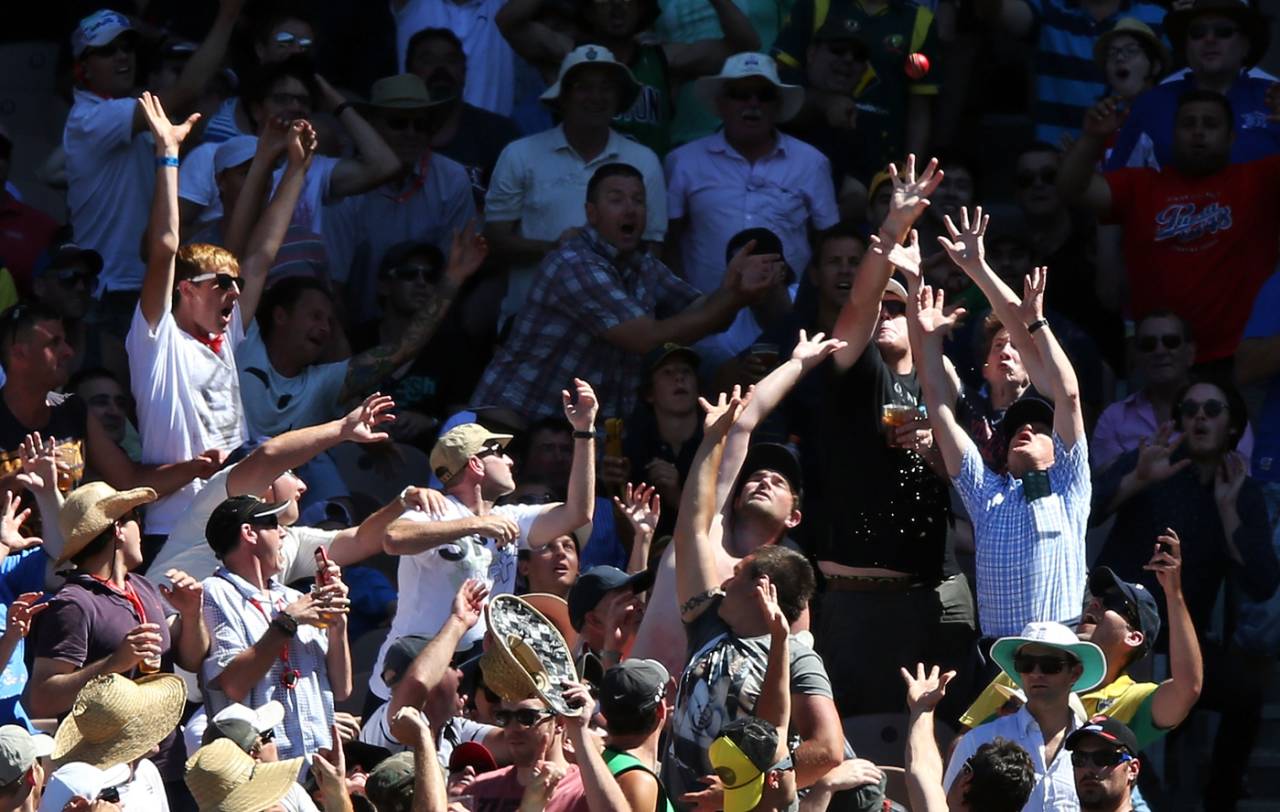The 52nd six
Watching and hearing a six hit at a ground is a visceral experience, even in an age when sixes are the norm, not the exception
Christian Ryan
30-Dec-2013

A six puts the spectator in the game, physically • Getty Images
Nearly no one goes to the cricket to watch the cricket. The view is closer and straighter, except for a few hundred seats behind the bowler's arm, on TV at home. You go to hear it and feel it. And when we talk about "feeling" it, actually what we still mean is hearing it. Were a field recordist to lay her audio pick-up equipment down between the laps of the people, on the Olympic Stand's second tier, on the day, last Friday, when the world record for number of sixes in a Test series was broken, she'd have caught the round-the-ground gulp when Jimmy Anderson's first ball bumped into Chris Rogers' pads.
The record-equalling 51st six of the series - a Jonny Bairstow top edge that cleared the rope, though not the fence - had landed late the previous evening. So people were waiting, for history.
With a Warner swing-and-miss came an ooooh with a 78,000-strong sonorous quality. His careful cut shot brought a rrah, tipping into a rrrray, as a chasing Englishman dived and failed to cut it off. The cheers welcoming Michael Clarke on his walk out to bat had an entertain-us-please swoon, beseeching him, wishing fireworks, which was not the same as the sound when Rogers, on 49, jabbed the ball and nodded yes and outran a necklace of ten fielders. Palpable in the din that time, the noise you heard was relief.
And the waiting spun on, into its 23rd hour - a murmuring hum, punctuated by gasps, tiny daggers they sounded like, which then always gave way to a river of clapping. Listening in, you could pinpoint the difference between the clapping for an intentional boundary and an accidental one: a quarter-second hush, until the eyes confirmed the result was the same, four runs, at which point the river took over and the clapping merged and became just the same too.
Brad Haddin hitting Ben Stokes back over his right shoulder was a moment of pure contact. From the bat, a crack; the crowd released a momentary roar; the ball soared, and dipped, sort of colliding with, not clearing, the fence. The historic 52nd six of the series was an occasion to note down the date, the 27th of December, 2013, just as the would-be literary historian Ronald Mason, aged 12, memorialised the hour - 15 September 1924 - when Frank Woolley and Percy Chapman were treating The Oval's gasometers like pepper-pots. "For the rest of the day I felt breathless, dizzy, almost ill; the ordinary world seemed unreal. But for years later, literally years, the memory of those moments… recurred to me… and steadied me at times when steadying was what I most needed."
Being there, at the ground, you can catch a six, drop it, touch it, wear it on your forehead, hear its whirr as it sails by. A six puts the spectator in the game, physically. Yet the six-hit, paradoxically, has traditionally been a feat out of bounds of the ordinary person. It required a mini-miracle of technique. A hundred-odd Vivian Richards sixes can be found on the internet. At Kensington Oval, Barbados, his muscle-heavy trunk arcs back even as his front foot steps forward, the leg carrying the weight, arms sweeping through like a wheel, wrists barely flicking at the ball, and up, up it javelins, and the rest is pure showmanship, not a stride down the pitch does he make, not a tremor shows on his face, just a slow-motion bite down on his chewing gum.
For the first century and a quarter of Test cricket, only Viv, Keith Miller and George Bonnor ever hit three sixes in an innings at the Melbourne Cricket Ground. Seven men have joined that club in the past dozen seasons. Over that same dozen-year stretch, the MCG has witnessed 7.33 sixes per Test; in the preceding 125 years, the average hovered around one.
No more is a mini-miracle needed. The six is beyond no batsman's reach. Yet the appeal of the six lingers. It is partly, perhaps, a numerical appeal. It is not anymore so visceral an appeal. Possibly other appeals rival it. The roar for Haddin's six, the 52nd six, was a roar worthy of all that waiting - "waiting" being a misnomer, in truth, because little mention was made of the world record-breaking blow at the time, and no mention at all in the next day's papers, not like in the days of Gerald's Brodribb's Hit for Six, published in 1960, when tales of sixes could light up entire books, newspaper headlines too:
Voce Hits Ball Into Hotel Bar
Gigantic Hit by Hammond
Budd's One Stroke - Six
Wellard's Giant Sixes - Hits Ball Into River
Four balls after the 52nd six, Mitchell Johnson clipped a ball off his hip, and the batsmen sprinted the first run fast enough that they got back for a hard-run two. Appreciation filled the air. Was there some difference in pitch between the clapping for the Johnson two and the Haddin six? None that any field recordist could have picked up. By far the loudest, teeth-rattlingest roar of 27 December 2013 came late in the day, after three minutes of giant-screen replays, when an lbw ball against Haddin was revealed to be missing leg stump, so the lbw decision was overturned. Fathers were reminiscing with their sons about that on the train ride home, their stories beginning something like: "Remember the umpire, how the index finger of his right hand javelined up, up…?"
Christian Ryan is a writer based in Melbourne. He is the author of Golden Boy and Australia: Story of a Cricket Country. His new book is Rock Country